As I write this on Sunday, October 8, 2023, the S&P 500 has registered declines in seven of the ten weeks since the end of July, falling about 6% since then.
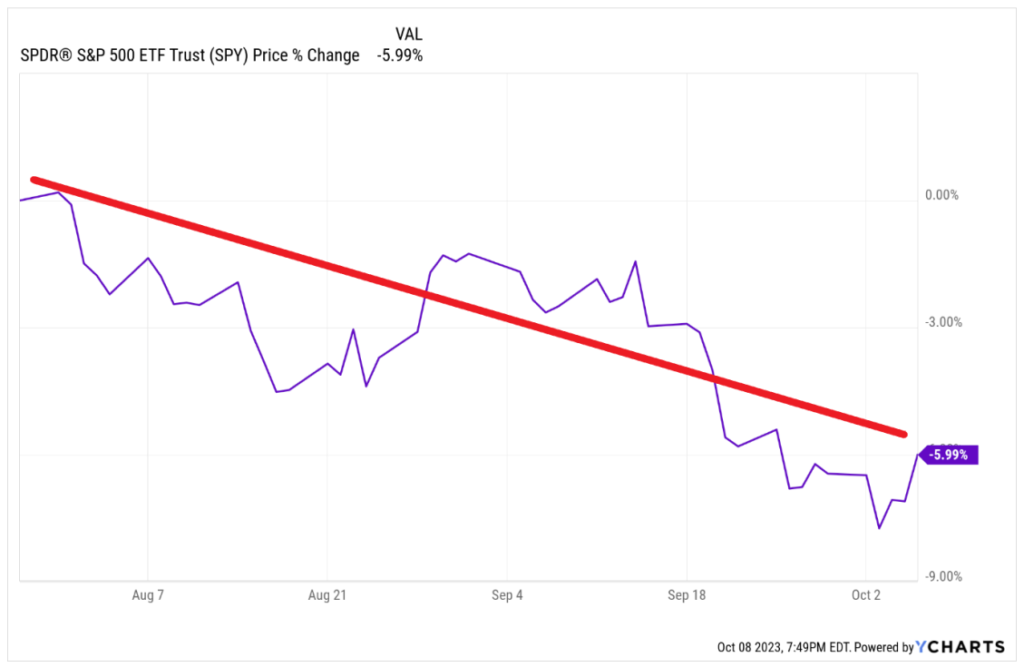 The impact on my Dividend Growth Portfolio (DGP) has been worse than the index, because of my focus on value and dividend-growth stocks, which are out of favor compared to the tech stocks that are propping up the whole index.
The impact on my Dividend Growth Portfolio (DGP) has been worse than the index, because of my focus on value and dividend-growth stocks, which are out of favor compared to the tech stocks that are propping up the whole index.
Since hitting its all-time (week-end) high total value of nearly $180,000 on July 21, the DGP’s total value has fallen by nearly 10% as of October 5 (most recent trading day).
That kind of short-term price setback does not cause me to sell in a panic. Instead, I keep moving forward with my strategic plan to build a growing stream of dividend income, to wit: I collect the dividends as they come in from my companies, register the good news when they announce dividend increases, and reinvest the dividends monthly to get more shares.
October’s Dividend Reinvestment
In 2022-23, I have used most of my monthly reinvestments to build up the DGP’s small positions – those under 3% of the portfolio. This month, I decided also to focus on the worst-performing sectors. My optimistic reasoning is that these not only present the best buying opportunities, but they are also likeliest to rebound when interest rates stop going up.
On the following graph, I circled the two worst-performing sectors in 2023:
- Real Estate – Down 9.7%
- Utilities – Down 20.1%
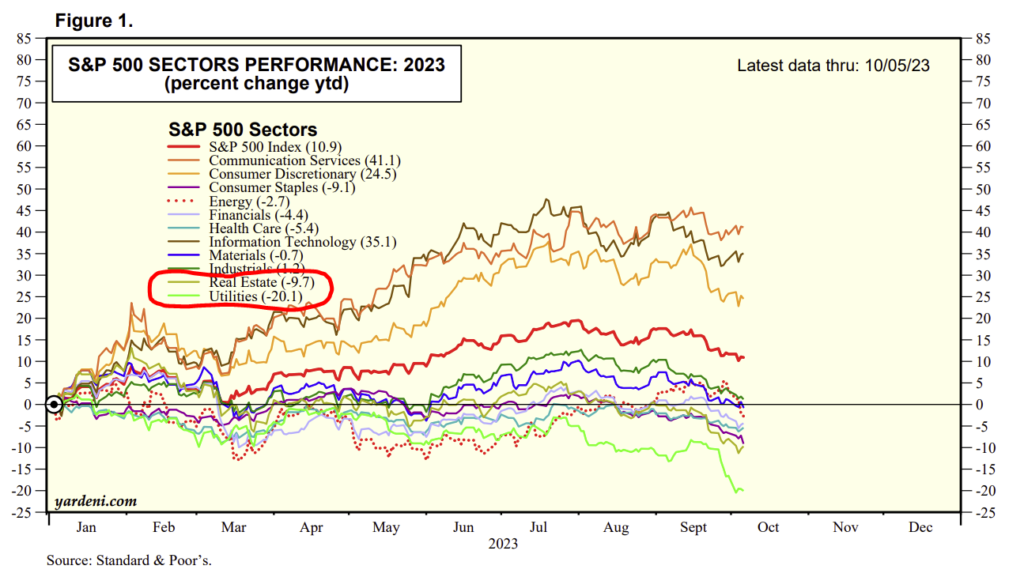 Source: Yardeni Research
Source: Yardeni Research
Coincidentally, while I was writing this article, Brian Bollinger, founder of Simply Safe Dividends, addressed the wisdom of investing in beaten-down utility and real-estate stocks in the current environment. Here is what Brian said:
Owning great businesses that generate reliable cash flow, provide time-tested products, and maintain prudent balance sheets takes a lot of risk off the table. But when periods of heightened volatility inevitably strike, don’t become part of the club Peter Lynch referred to when we he said that everybody is a long-term investor until the market goes down.
“People have been successful investors because they’ve stuck with successful companies. Sooner or later the market mirrors the business.” – Warren Buffett
So my universe of stocks to pick from this month became: Small positions in my portfolio that are in either the Utilities or Real Estate sectors.
There are four such candidates. I scored their Quality and Dividend Snapshots, and valued each one.
 In examining these stocks, I found what I expected to find: Such stocks now offer high yields and good valuations.
In examining these stocks, I found what I expected to find: Such stocks now offer high yields and good valuations.
In the table above, two stocks have green (favorable) data in every column: Evergy (EVRG) and Crown Castle (CCI). There is one stock from each sector, and I really could have chosen either one, or split the money.
I have been purchasing both stocks frequently as I build them up. Evergy has grown to 2.8% of my portfolio, while CCI is at 2.7%.
So I flipped a virtual coin. Siri said “tails,” so I bought Crown Castle again.
CCI is in the Telecom Tower REIT industry of the Real Estate Sector. Its price performance this year has been dismal, even with dividends reinvested.
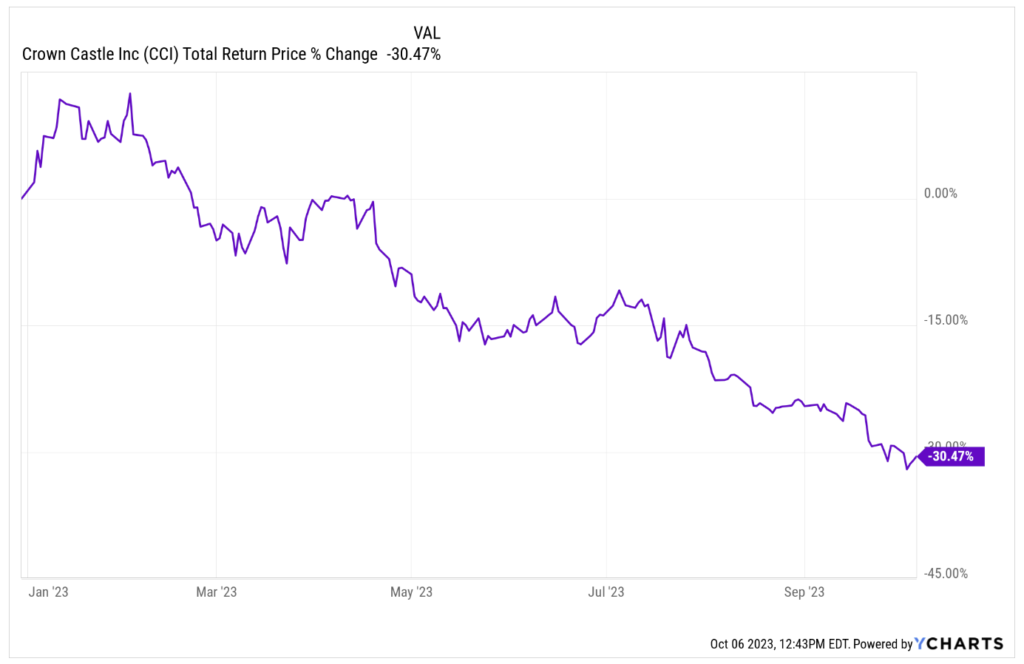 However, its dividend performance has been good for several years.
However, its dividend performance has been good for several years.
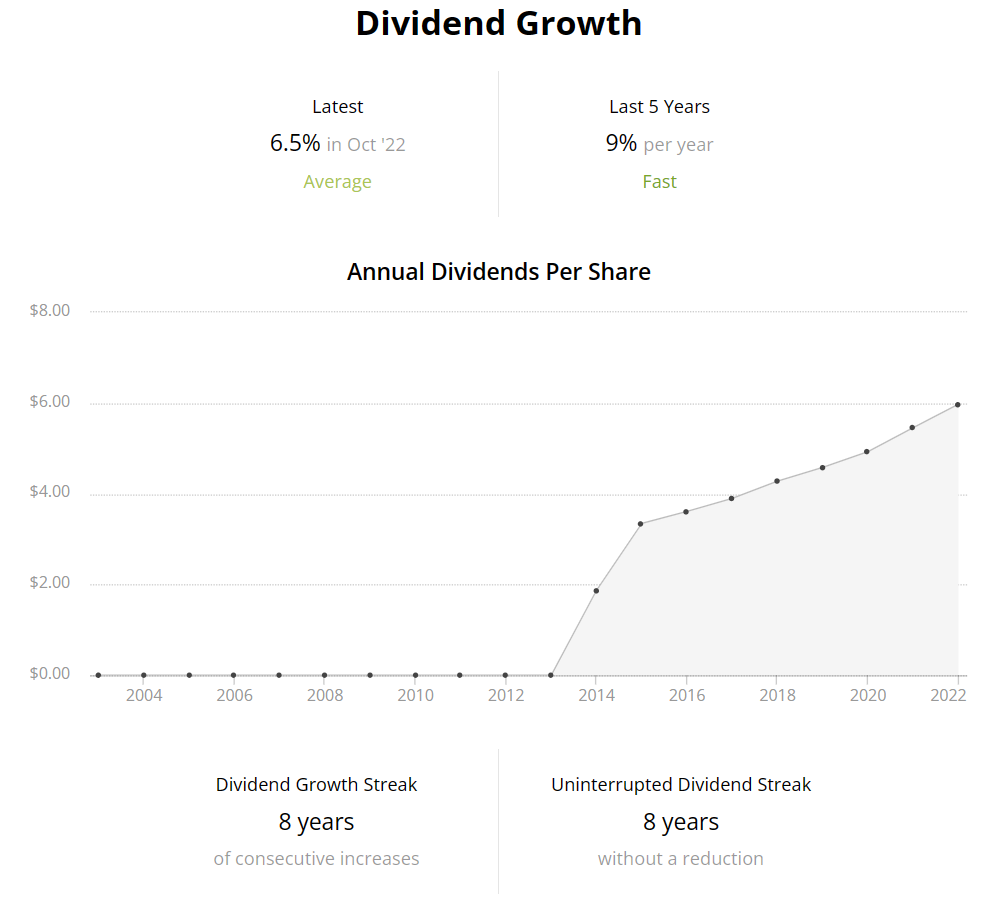 Source: Simply Safe Dividends
Source: Simply Safe Dividends
Wall Street projects significant price upside for CCI, with the average one-year price target being 35% above CCI’s current price.
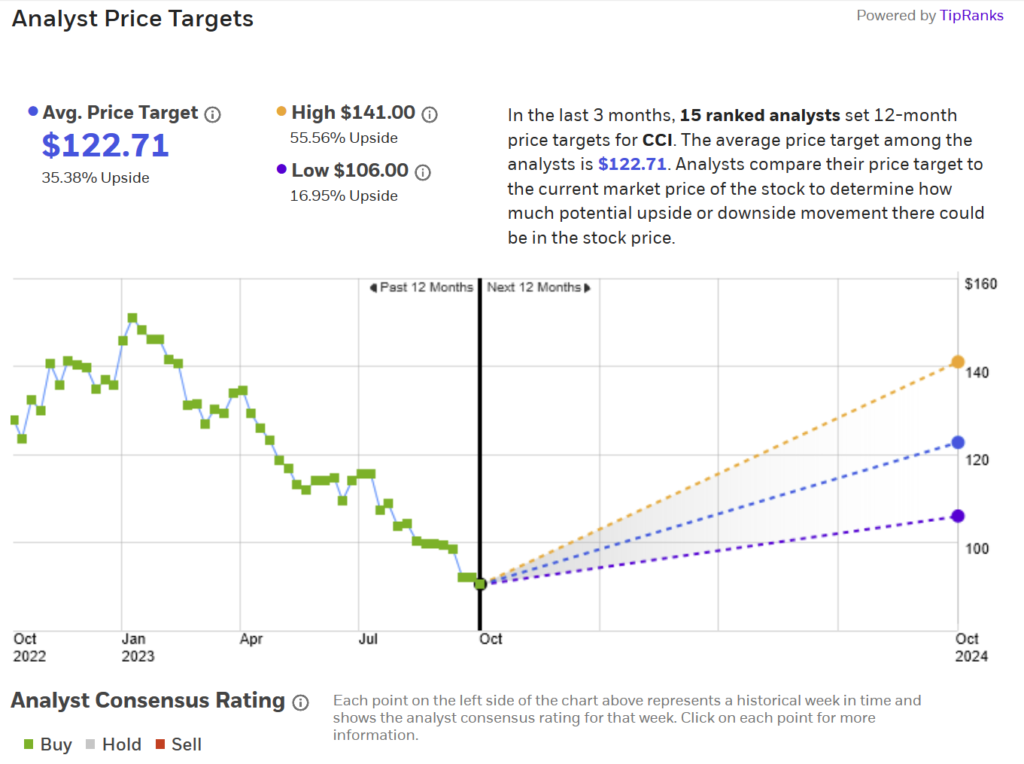 Source: E-Trade
Source: E-Trade
Therefore, for the fourth time this year, I selected CCI for my monthly dividend reinvestment. Each time I have bought the stock, it has been more undervalued than last time, so I keep getting the shares at higher yields.
Here is a summary of this month’s purchase.
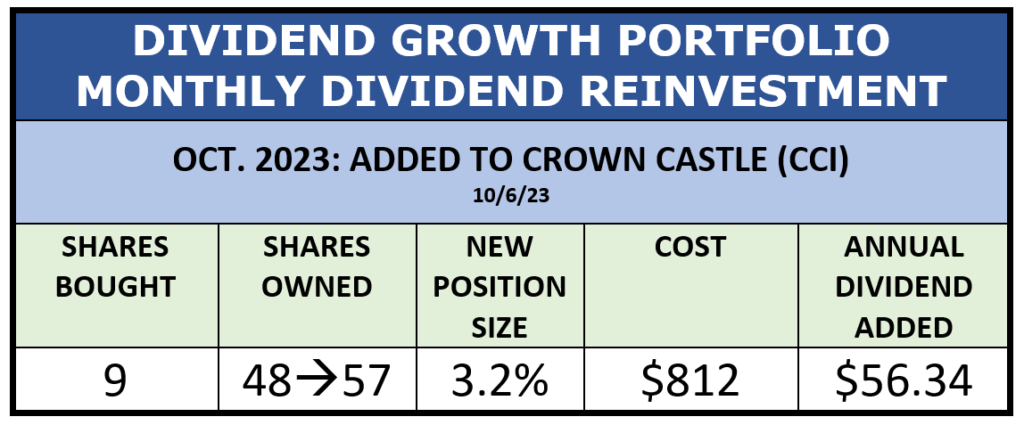 Source: Author
Source: Author
CCI just paid out its Q3 dividend at the end of September, so these new shares did not qualify for that payment. But CCI normally announces its annual dividend raise prior to its December (Q4) payment, so the new shares (along with all the others) will benefit from that increase.
This purchase pushes CCI above 3% of my portfolio, so it probably will not be on the list of potential stocks to purchase in coming months. I will continue attending to the other small positions.
Full Portfolio Review
The primary purpose of the Dividend Growth Portfolio, as stated in its Business Plan, is:
Build a reliable, steadily increasing stream of dividends over many years that can eventually be used as income for retirement.
The portfolio’s dividends go up for the three reasons shown on this card:
 Source: Author
Source: Author
(1) Dividend increases
The DGP has received 28 dividend-increase announcements so far this year.
On the following display, I condensed the first 6 months onto one line to save space. The highlighted entries are 5 new increase registered since last month, including whoppers (pun intended) from Microsoft (MSFT) at 10.3% and McDonald’s (MCD) at 9.9%.
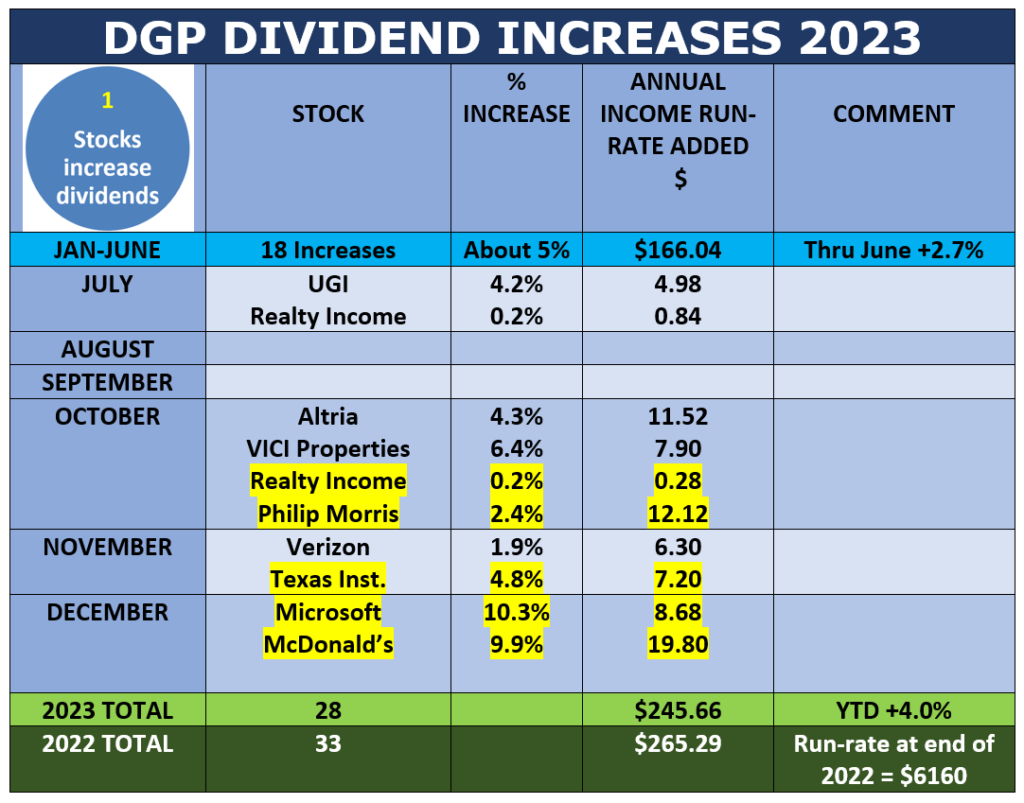 Source: Author
Source: Author
I still expect to receive about 5 more increases effective in 2023 by the end of the year. So far this year, the increases have added 4% to the DGP’s annual income run-rate compared to the end of last year.
(2) Dividend reinvestments
Reinvesting dividends is the second reason the DGP’s income steadily goes up. I collect dividends in cash as they come in, then reinvest them once each month.
Since dividends are paid per share, each additional share purchased through dividend reinvestments causes the portfolio’s income to rise. It is compounding at work: I am earning more money (future dividends) on money already earned (dividends collected in the prior month).
The next table shows the DGP’s dividend reinvestment program so far this year, with the new purchase of Crown Castle highlighted. So far this year, I have made ten reinvestments into five different securities.
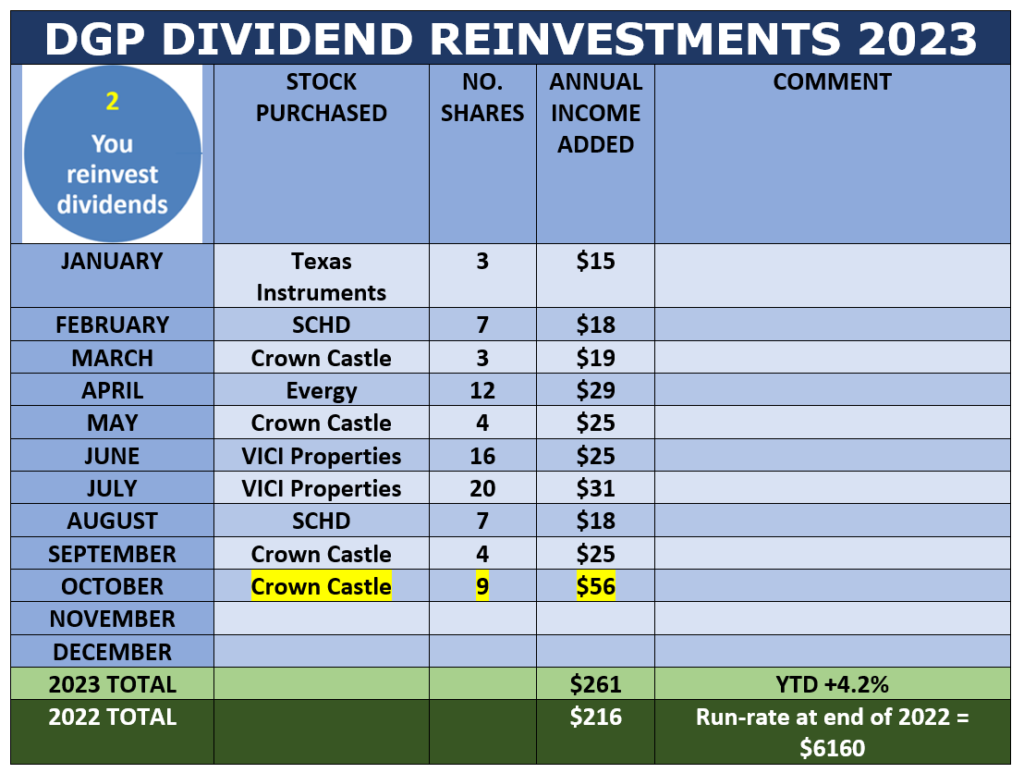 Source: Author
Source: Author
Note that 2023’s monthly reinvestments are increasing the portfolio’s income faster than last year’s reinvestments. That is also a characteristic of compounding, plus this year the effect has been exaggerated by the better yields resulting from declining prices.
I have already surpassed last year’s reinvestment income ($261 so far this year vs. $216 in 2022). That adds 4.2% to the annual dividend run-rate compared to the end of last year.
(3) Portfolio management
The third reason that dividends go up in this portfolio is that, from time to time, I adjust the portfolio. The reasons might be to trim or sell a disappointing stock, trim a position that has become oversized, and so on.
Some individual trades and adjustments reduce the income stream for a short time, but overall, portfolio adjustments tend to increase the income stream on a long-term basis.
I made no such changes in the past month. During 2023 so far, I have changed about 6% of the portfolio through sales, trims, and replacements, resulting in a modest increase of $5 to the annual dividend run-rate.
Here is my watch list for possible future actions.
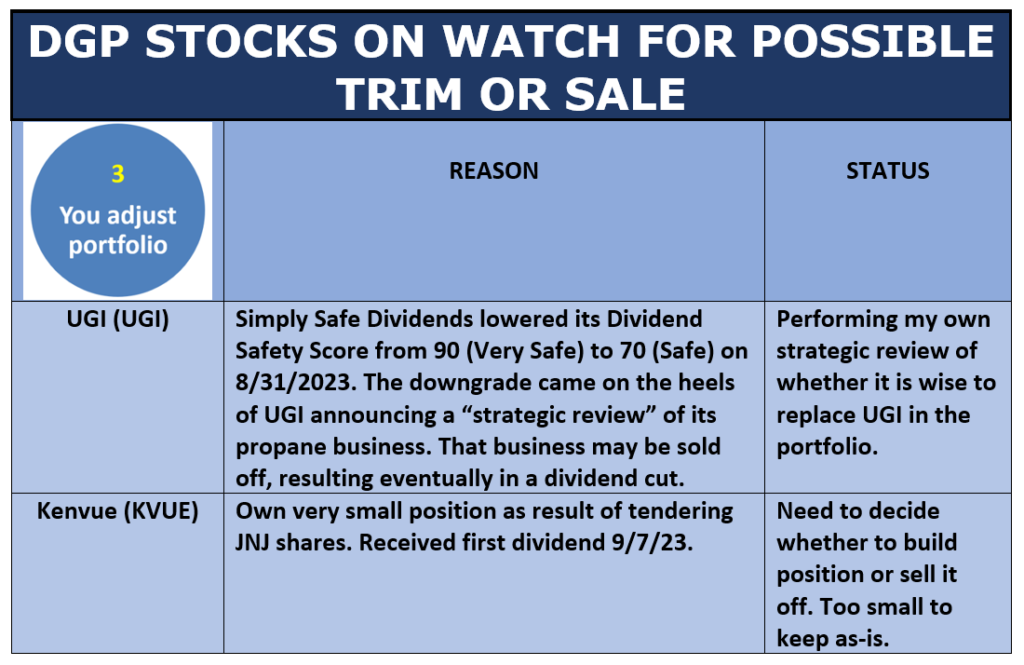 Source: Author
Source: Author
(4) Income growth record
The primary goal of the DGP – to build a reliable, steadily increasing stream of dividends over the long term – has been, and continues to be, achieved, as shown here:
 Source: Author
Source: Author
The full-year 2023 estimate is the sum of dividends already collected through September ($4758) plus dividends expected during the remainder of the year (at current payout rates).
Through the end of September, dividends collected in 2023 are 10.3% more than the dividends collected last year through September. The long-term CAGR of the annual dividends (2009-2022) has been 10.4% per year.
The 2024 estimate is simply the 2023 estimate plus 9% as a SWAG.
Different Ways of Looking At the Portfolio
The full portfolio is always available here. That’s an alphabetical list, with yields, position sizes, and other common statistics.
Sometimes it is helpful to view the portfolio in different ways. This month, I created the following overview showing position sizes, sectors, and super-sectors.
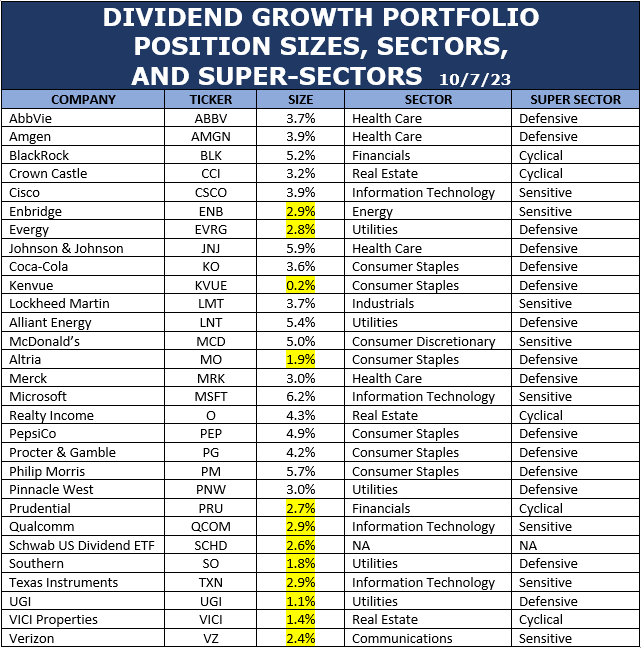 Source: Author
Source: Author
The highlighted positions are those under 3% of the portfolio. Focusing on those smaller positions, in the coming months I intend to continue to improve the portfolio by eliminating weaker holdings and growing the stronger ones.
Most investors are familiar with sectors. The most common industrial classification system is GICS, which stands for Global Industry Classification Standard. The name, and its abbreviation GICS, are registered trademarks of MSCI and S&P Dow Jones Indexes, which developed and maintain the system.
GICS divides the financial universe into 11 sectors, which hold 74 industries.
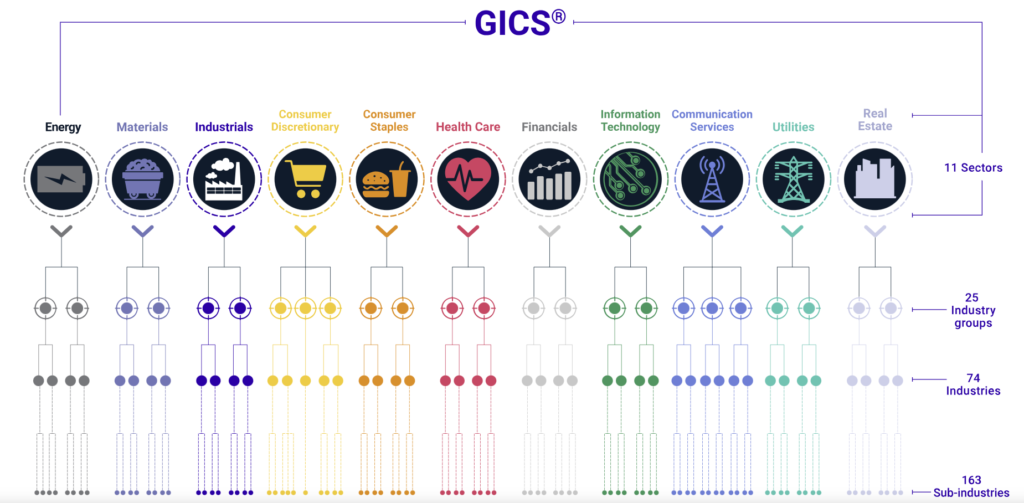 Source: MSCI
Source: MSCI
There is no “official” definition of Super Sectors (they are not part of GICS), but they are designations commonly used by investors to reflect the economic exposure of the GICS sectors.
The three Super Sectors are the following, listed in order of most economically sensitive to least sensitive.
- Cyclical:
- Basic Materials
- Consumer Cyclical (or Discretionary)
- Financials
- Real Estate
- Sensitive:
- Communication Services
- Energy
- Industrials
- Information Technology
- Defensive:
- Consumer Defensive (or Staples)
- Healthcare
- Utilities
Cyclical sectors (and the industries within them) are considered to be the most susceptible to volatile changes in the economic cycle. Stocks in Cyclical sectors tend to perform worst when the economy is slowing down or contracting (as in a recession), but they also tend to rebound fastest when the economy is speeding up (or is anticipated to speed up).
The Sensitive Super Sector is in the middle. It includes sectors that are not so linked to the economy as to be Cyclical, but nevertheless tend to be affected by economic twists and turns.
The Defensive sectors include companies that tend to be least affected by economic trends. Their stocks tend to not drop as much in price during economic slowdowns, but they do not tend to rise as much during expansions either. They rarely lead the charge ahead when the market becomes bullish.
With the foregoing in mind, I put together this look at how my portfolio is diversified among Super Sectors:
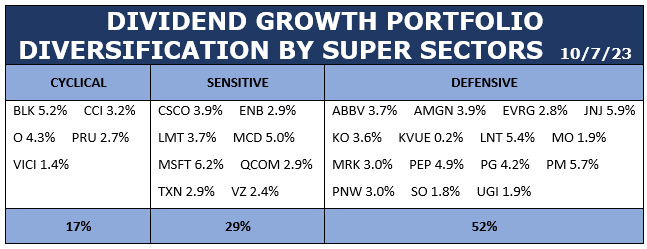 Source: Author
Source: Author
As you can see, my DG portfolio tilts markedly toward Defensive stocks. Of course, the theory does not always play out, as shown this year by the hammering that “defensive” utilities have taken.
History of the DGP
My Dividend Growth Portfolio (DGP) is now in its 16th year. The DGP is real, meaning that it is not a hypothetical, a “model,” or a back-test. All decisions about managing it have been made in real time with real money.
 Source: Author
Source: Author
If you want to see the full portfolio at any time, its holdings at the end of the previous month are always available here. That link also has an archive of all the articles and videos that I have published about the portfolio.
That wraps things up for this month. Thanks for reading!
-–Dave Van Knapp
Apple to SHOCK Emerging $46T Industry [sponsor]Silicon Valley venture capitalist Luke Lango says this little-known Apple project could be 10X bigger than the iPhone, MacBook, and iPad COMBINED! Investing in Apple today would be a smart move... but he’s discovered a bigger opportunity lying under Wall Street’s radar -one that could give early investors a shot at 40X gains! Click here for more details.
Source: Dividends & Income
